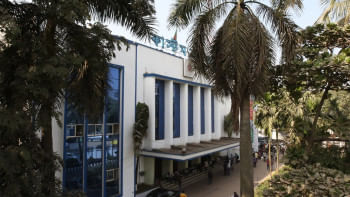2020’s top astrophysicist Tonima Tasnim Ananna from Bangladesh explains just why black holes are so cool

Black holes have long piqued the interest of scientists. From what was once regarded as a mathematical curiosity, the lingering mystery of black holes permeates many fields of scientific research encompassing mathematics, physics, astronomy and now computer simulations.
Bangladeshi astrophysicist Tonima Tasnim Ananna, who recently topped the 2020 edition of Science News (SN) magazine's SN 10: Scientists to Watch, has been lauded for her outstanding groundbreaking research on black holes, including their origins and subsequent expansion over time. Her research has mapped the grandeur of black holes tracing its origins, location, and its effect on its surroundings.
Toggle caught up with Ananna for a chat, in hopes of understanding the fascinating phenomena of black holes.
Toggle: How important are black holes in our understanding of the cosmos?
Ananna: Supermassive black holes that reside in the centers of galaxies are known to co-evolve with these galaxies. The energy outbursts from the environment surrounding these black holes can either trigger star formation by disturbing neutral, cold gas clouds which gravitationally collapse to form stars or stop star formation if they inject too much energy into these clouds, making them evaporate. Therefore, to understand how galaxies evolve and what triggers or stops star formation, understanding how black holes evolve is paramount.
However, independent of their roles in galaxy evolution, supermassive black holes are some of the most mysterious objects we find in nature. It is still unclear how they form. Stellar-mass black holes (such as Cygnus X-1) might have been produced by collapsing stars, or from mergers of other dense objects such as neutron stars.
However, supermassive black holes, which are usually a million to a billion times the mass of the sun, had to form very soon after the Big Bang. The Cosmic Microwave Background shows that after the Big Bang, matter was almost uniformly distributed throughout the Universe, with very small perturbations. Over time, the small perturbations developed into superclusters of galaxies (where there was an overdensity of matter) or supervoids (where there were under-densities).
At the center of every massive galaxy, we find supermassive black holes, so the seeds of these black holes must have been formed when matter first started collapsing due to these perturbations - but the exact process that caused them to form is still unclear. To me, understanding how these objects formed and under what conditions they accumulated most of the matter to become so massive is interesting in itself.
Toggle: What can we say about the origins and expansion of black holes given the strides made in research about them?
Ananna: We have a pretty good understanding of how supermassive black holes that are not shrouded in large quantities of gas and dust have evolved in the last 12 billion years. With upcoming missions such as the James Webb Space Telescope, which observed the Universe in infrared wavelengths, we should have a clearer picture of earlier black holes.
The reason we need an infrared telescope to see further back in the Universe is due to the Doppler effect (put very simply, the faster an object moves away from us, the redder the light emitted from it appears relative to its stationary counterpart). As the Universe is expanding due to Dark Energy, galaxies are moving further away from us. The further away a galaxy is from us, the faster it is moving away from us. Therefore, for the furthest galaxies/supermassive black holes, even all the ultraviolet radiation gets shifted to infrared wavelengths.
The black holes shrouded in gas and dust are aplenty in the local Universe, but they are difficult to see in most wavelengths (such as visible light and ultraviolet) because these wavelengths are stopped by absorption from the surrounding clouds. In the last decade and a half, two orbiting X-ray observatories - Swift-BAT and NuSTAR have been launched. X-rays are able to pass through these heavy clouds, finally giving us a glimpse into the environment surrounding these hidden black holes. This new data is allowing us to paint a complete picture of black hole growth.
Toggle: You and your team have been able to get a clearer look at the spin rate of the black holes, an important characteristic. Could you elaborate on how this breakthrough is important?
Ananna: The three fundamental characteristics of a black hole are its mass, charge, and spin. While mass can be directly calculated using velocities of stars around these black holes, the spin is more intrinsic and has to be derived from looking at the relationship between mass and light. Because our result accounts for all the light emitted by supermassive black holes in the last twelve billion years, and we have measurements of black hole mass density in the present universe in literature, we are able to understand what the average spin of these black holes have been over time.
Even though previous models which did not account for much of the obscured/hidden AGN predicted that black holes are mostly stationary (i.e., Schwarzschild black holes), we find that rotating Kerr black holes are much more common than previously expected. The solution for general relativity that describes a rotating black hole (found in the 1960s) is very different from that of a stationary black hole (found a year after general relativity was proposed by Einstein in 1915), and the way space curves around a rotating black hole is also different (for example the disk of infalling matter can move closer to the event horizon if the disk and the black hole are both rotating in the same direction).
Therefore the spin measurement does move us closer to understanding the environment around these black holes.
Toggle: What are the major challenges in your research and where do you plan to venture next in the realm of black holes?
Ananna: One major challenge in research is balancing quality vs quantity. There is always pressure to publish as much and as quickly as possible, even though to produce something of value it is best to take a step back and take your time. A few years ago there was an excellent article about this, titled "Scientific knowledge is drowning in a flood of research" - a series of comics in that article perfectly sums up this issue that researchers face today.
About my current projects - right now, I am working with data from an X-ray observatory called Swift-BAT, which observes the universe in high-energy X-rays, but it only observes the local universe. Due to X-rays penetrating power, this will allow us to draw the most complete picture of how mass is distributed in local populations of black holes, update the mass density estimate which is still widely debated, and quantify how much of the infalling mass is radiated away as light.
Toggle: What do you think are the major barriers in Bangladesh in researching such topics, and what are your recommendations in overcoming them?
Ananna: I think the major barrier in research is that our public institutions value connections over merit when it comes to recruitment. It is difficult to hold on to talent if it is not valued. Another important aspect of research is funding.
Researchers in the US regularly propose research projects to NASA and NSF (National Science Foundation), which are reviewed by peers, and the most meritorious projects are funded. All of my research projects have been funded by NASA and NSF grants. In Bangladesh, at least in the sciences, I have not heard of anything similar. It is unlikely that a research environment will thrive if people cannot get funding to collect data, hire graduate students and postdocs.
Illustration: Zarif Faiaz

 For all latest news, follow The Daily Star's Google News channel.
For all latest news, follow The Daily Star's Google News channel. 



Comments